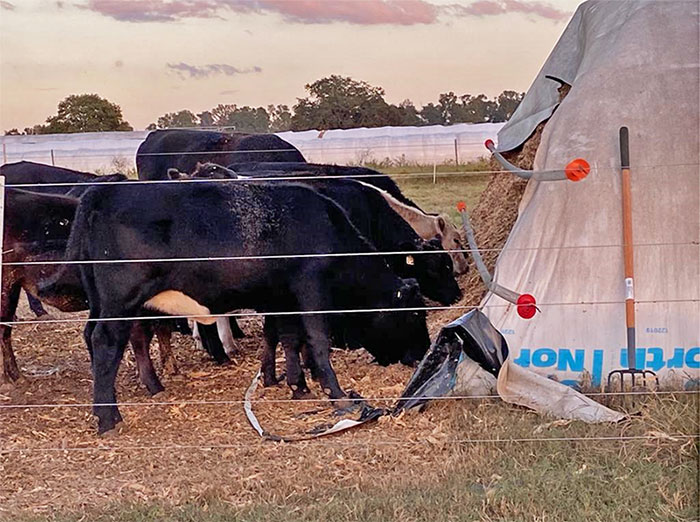Florida researchers test self-fed silage bags |
| By Mike Rankin, Managing Editor |
|
|
 Photo: University of Florida Conventional feeding systems involve not only the cost of the feed but also a considerable investment in labor and equipment. To lower these costs, researchers at the University of Florida’s North Florida Research & Education Center in Marianna are evaluating a system whereby beef cattle are being self-fed from silage bags. The silage bags are fenced off using electrified wire, then two additional hot wires are placed across the open face of the bag. Cattle are allowed to eat silage free choice from the bag or the time of bag access can be limited based on nutrient needs. “This approach can be implemented on a small or large scale for both growing and mature cattle,” notes Nicolas DiLorenzo, an extension beef nutrition specialist. “While there is no control of the silage intake, this free-choice approach system eliminates the need for tractors, feed wagons, or diesel.” DiLorenzo advises that the silage bags need to be placed in a well-drained location to minimize any mud issues, and the bags need to be opened to the south so that the feeding area receives maximum sunlight. “Once the bags are opened, oxygen penetrates the ensiled forage, and this allows yeasts to grow and cause spoilage,” DiLorenzo says. “Therefore, it is important to allow cattle to consume enough material every day, so it does not spoil and waste.” The beef specialist recommends that cattle consume at least 1 foot of bag per day during the winter and 1.5 feet during the summer to minimize spoilage. The use of a bacterial inoculant to enhance aerobic stability is also advised. The frontal advance of the cattle is controlled by two electric wires that stretch in front of the face and between the side perimeter wires. According to DiLorenzo, cattle quickly learn how to eat silage from the front of the bag while avoiding the hot wires. “The self-feeding area should be attended to daily to make a new section of the bag available by removing a slice of the plastic bag and to adjust the hot wires forward, allowing cattle access to fresh material every day,” DiLorenzo explains. “This can be handled by one person pretty quickly. The only tools needed for the daily care are a pocketknife and a pitchfork, which is used to push up any loose silage at the bottom behind the wire.” Stock appropriately A correct stocking rate for the system will depend on the size of the bag, the moisture content, the packing density, and the daily frontal advance. DiLorenzo notes that stocking rates can vary from 50 to more than 100 head per bag. All animals have to be able to access the silage bag(s) with minimal competition. “A good indicator of a correct stocking density is when all cattle in the paddock are resting at the same time and none of the animals exhibit anxious behavior or are looking for feed,” DiLorenzo says. “Weighing the group every few weeks or monthly can help determine if the target gains are being achieved.” The system works best when all of the cattle with access to the same bags are of similar size and weight. If self-fed bags are used for growing cattle, DiLorenzo notes that most ensiled forages, with the exception of possibly winter annuals or legumes, may be deficient in protein, and supplementation may be needed. In a recent test conducted at the research station, a reduction of 40% in average daily gain was observed in heifers self-fed corn silage without protein supplementation (1.5 pounds per day), when compared with heifers fed corn silage plus 10% cottonseed meal on a dry matter basis (2.5 pounds per day). Corn and sorghum silages have a high energy concentration due to their starch content, if harvested at the right maturity. Perennial warm-season grasses and winter annuals can also be ensiled, but they require wilting to reduce moisture, DiLorenzo notes. He also points out that cow-calf producers can self-feed silage bags of warm-season perennials to mature cows during periods of grass shortage, which avoids the need to feed round bales. A short video of the silage bag system can be viewed here. |
